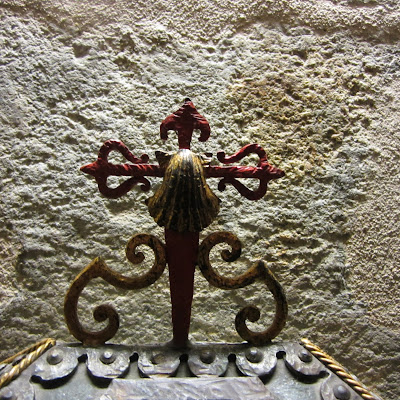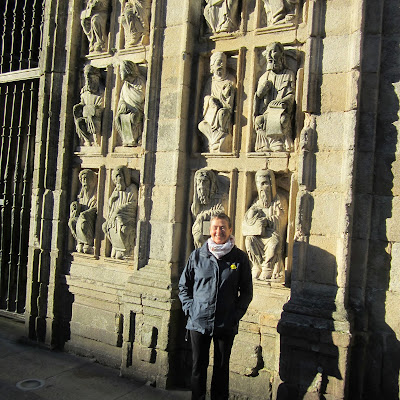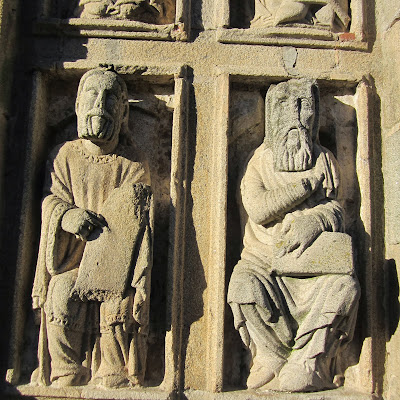Early morning sunrise over the Atlantic from our ship, the Aurora.
It was just like watching an egg being broken open and I found it a fitting metaphor for the grace filled gifts of Advent.
Grace: A Permanent Climate of Divine Kindness
"Grace is one of the most majestic words in theology. It suggests the sublime spontaneity of the divine which no theory or category could ever capture. Grace has its own elegance. It is above the mechanics of agenda or operation. No one can set limits to the flow of grace. Its presence and force remain unmeasurable and unpredictable. Grace also suggests how fluent and seamless the divine presence is.
There are no compartments, corners or breakages imaginable in the flow of grace. Grace is the permanent climate of divine kindness. It suggests a compassion and understanding for all the ambivalent and contradictory dimensions of the human experience and pain. This climate of kindness nurtures the sore landscape of the human heart and urges torn ground to heal and become fecund. Grace is the perennial infusion of springtime into the winter of bleakness."
— Beauty: The Invisible Embrace -John O'Donohue
and in his chapter on the Ocean as Immense Divinity John O'Donohue speaks of the presence of the ocean is so huge that it resembles the divine. "Surprising in such a huge force is its perfect sense of rhythm. The ebb and flow of the tide resemble the human breath, not surprising given that each of us came here from the waters of the womb and that primally we have come from the ocean at the beginning of evolution.
He also says the theme of expectation intensifies when the land stands for the masculine and the ocean for the feminine.
Grace: A Permanent Climate of Divine Kindness
"Grace is one of the most majestic words in theology. It suggests the sublime spontaneity of the divine which no theory or category could ever capture. Grace has its own elegance. It is above the mechanics of agenda or operation. No one can set limits to the flow of grace. Its presence and force remain unmeasurable and unpredictable. Grace also suggests how fluent and seamless the divine presence is.
There are no compartments, corners or breakages imaginable in the flow of grace. Grace is the permanent climate of divine kindness. It suggests a compassion and understanding for all the ambivalent and contradictory dimensions of the human experience and pain. This climate of kindness nurtures the sore landscape of the human heart and urges torn ground to heal and become fecund. Grace is the perennial infusion of springtime into the winter of bleakness."
— Beauty: The Invisible Embrace -John O'Donohue
and in his chapter on the Ocean as Immense Divinity John O'Donohue speaks of the presence of the ocean is so huge that it resembles the divine. "Surprising in such a huge force is its perfect sense of rhythm. The ebb and flow of the tide resemble the human breath, not surprising given that each of us came here from the waters of the womb and that primally we have come from the ocean at the beginning of evolution.
He also says the theme of expectation intensifies when the land stands for the masculine and the ocean for the feminine.
We took the coach from the port in La Coruna in Northern Spain to Santiago Compostela, a trip of about an hour. Our pilgrimage was a bit of a cheat compared to the walkers way !
The statue above is of St Francis of Assisi opposite the convent of of St Francis.
The statue above is of St Francis of Assisi opposite the convent of of St Francis.
The foundation of this convent is attributed to St Francis who went on pilgrimage to Santiago around 1214. He always offered care to walkers, a tradition which remains to the present day.

In 2014 the city celebrates 800 years since his pilgrimage and will be visited by Pope Francis. We visited here back in May but it was raining and this time we were graced with sunshine ! I've also included some extra photos from the May trip.

In 2014 the city celebrates 800 years since his pilgrimage and will be visited by Pope Francis. We visited here back in May but it was raining and this time we were graced with sunshine ! I've also included some extra photos from the May trip.
 | |||||
| Above outside the convent of St Francis |
St James the Apostle preached in Galicia and,
after his death in Palestine, was brought back by stone boat and buried
here. The tomb was supposedly rediscovered in about 814 by a religious
hermit following a guiding star, hence the name 'Compostela' –
from the Latin campus stellae, field of the stars. The Asturian
king Alfonso II had a church erected above the holy remains, pilgrims
began flocking to it and by the 11th century the pilgrimage was becoming
a major European phenomenon, bringing a flood of funds into the city.
Bishop Gelmírez obtained archbishopric status for Santiago in 1100 and
added numerous churches in the 12th century.
The following few
centuries, however, were marked by squabbling between rival nobles and
Santiago gradually slipped into the background. It is only since the 1980s, that Santiago has been the capital of the autonomous region of Galicia.
Below a street musician playing the Galician pipes
underneath the grand arch that leads to the Cathedral Square.
Inside the cathedral- below inside in May.
A pilgrim's backpack with the iconic symbol of the scallop shell
of the Camino. Read more on the symbolism of the shell here.
 |
| The tomb of St James |
 | |
| Dry pilgrim arriving on foot and below in May, two wetter bikers. |
The image above and those below show the wonderful figures
on the Holy Door or Door of Forgiveness on the Western side of the cathedral which is only openedduring Holy Jubilee Years. It won't be open again until 2021.
The images below show St James and his disciples including Theodore and Anastasio.
This door symbolises spiritual renewal.
Walking the narrow medieval streets..
The museum of pilgrimage was a delight featuring the history of pilgrims
A moving exhibit of a pilgrim's footwear from the East
The Visitation- Mary greets her cousin Elizabeth
Above a beautifully decorated cantimplora or water bottle
from the 17th /18th century
A sketch book made by a pilgrim on the Camino
The Papal Bull and seal of Pope Gregory XIII granting a plenary indulgence in 1574 to
pilgrims and those who often ended up in the hospital after their walk.
Students from the University of Santiago gathering on the steps -
maybe celebrating the end of term.
Comings and goings..




















































































No comments:
Post a Comment